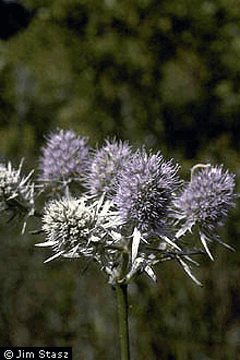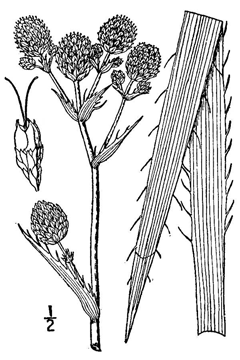 |
|
Jim Stasz @ USDA-NRCS PLANTS Database |
 |
| USDA-NRCS PLANTS Database / Britton, N.L., and A. Brown. 1913. An illustrated flora of the northern United States, Canada and the British Possessions. Vol. 2: 622. |
Translate this page:
Summary
Physical Characteristics

 Eryngium aquaticum is an evergreen Perennial growing to 1.2 m (4ft).
Eryngium aquaticum is an evergreen Perennial growing to 1.2 m (4ft).
See above for USDA hardiness. It is hardy to UK zone 6. It is in leaf all year, in flower from July to August. The species is hermaphrodite (has both male and female organs) and is pollinated by Bees, flies, beetles. The plant is self-fertile.
Suitable for: light (sandy) and medium (loamy) soils, prefers well-drained soil and can grow in nutritionally poor soil. Suitable pH: mildly acid, neutral and basic (mildly alkaline) soils. It cannot grow in the shade. It prefers dry or moist soil. The plant can tolerate maritime exposure.
UK Hardiness Map
US Hardiness Map
Synonyms
Plant Habitats
Bog Garden; Cultivated Beds;
Edible Uses
References More on Edible Uses
Medicinal Uses
Plants For A Future can not take any responsibility for any adverse effects from the use of plants. Always seek advice from a professional before using a plant medicinally.
Antidote Diaphoretic Diuretic Emetic Expectorant Homeopathy
The plant is diaphoretic, diuretic, expectorant and in large doses emetic[207]. It is used mainly in the treatment of disorders of the kidneys and sexual organs[238, 257]. It has been used as an antidote to snake poison[207, 257]. The pounded roots are used as a diuretic[213]. An infusion of them is used to reduce fevers[213]. The plant is used as an antidote to snakebites. The roots are chewed and applied to the bite[213]. A homeopathic remedy is made from the fresh or dried root[4].
References More on Medicinal Uses
The Bookshop: Edible Plant Books
Our Latest books on Perennial Plants For Food Forests and Permaculture Gardens in paperback or digital formats.

Edible Tropical Plants
Food Forest Plants for Hotter Conditions: 250+ Plants For Tropical Food Forests & Permaculture Gardens.
More

Edible Temperate Plants
Plants for Your Food Forest: 500 Plants for Temperate Food Forests & Permaculture Gardens.
More

More Books
PFAF have eight books available in paperback and digital formats. Browse the shop for more information.
Shop Now
Other Uses
References More on Other Uses
Cultivation details
Requires a well-drained soil and a sunny position[1]. Prefers a light sandy soil but tolerates most soil types including lime and poor gravels[200]. Plants should be put in their final position whilst small since they resent root disturbance[200]. Plants labelled in nurseries as E. aquaticum are often E. yuccifolium[200].
References Carbon Farming Information and Carbon Sequestration Information
Temperature Converter
Type a value in the Celsius field to convert the value to Fahrenheit:
Fahrenheit:
The PFAF Bookshop
Plants For A Future have a number of books available in paperback and digital form. Book titles include Edible Plants, Edible Perennials, Edible Trees,Edible Shrubs, Woodland Gardening, and Temperate Food Forest Plants. Our new book is Food Forest Plants For Hotter Conditions (Tropical and Sub-Tropical).
Shop Now
Plant Propagation
Seed - best sown as soon as it is ripe in early autumn on the surface of a well-drained compost in a cold frame[200]. The seed can also be sown in spring. It usually germinates in 5 - 90 days at 20°c. When they are large enough to handle, prick the seedlings out into individual pots and grow them on in the greenhouse for their first winter. Plant them out into their permanent positions in late spring or early summer, after the last expected frosts. Division in early spring or autumn. Take care since the plant resents root disturbance[200]. Root cuttings in autumn or winter[200].
Other Names
If available other names are mentioned here
Native Range
NORTHERN AMERICA: United States (New Jersey, Pennsylvania (extirpated?), Alabama (south), Delaware, Florida (north), Georgia (southeast), Maryland (east), North Carolina (east), South Carolina, Virginia (east))
Weed Potential
Right plant wrong place. We are currently updating this section.
Please note that a plant may be invasive in one area but may not in your area so it's worth checking.
Conservation Status
IUCN Red List of Threatened Plants Status :

Growth: S = slow M = medium F = fast. Soil: L = light (sandy) M = medium H = heavy (clay). pH: A = acid N = neutral B = basic (alkaline). Shade: F = full shade S = semi-shade N = no shade. Moisture: D = dry M = Moist We = wet Wa = water.
Now available:
Food Forest Plants for Mediterranean Conditions
350+ Perennial Plants For Mediterranean and Drier Food Forests and Permaculture Gardens.
[Paperback and eBook]
This is the third in Plants For A Future's series of plant guides for food forests tailored to
specific climate zones. Following volumes on temperate and tropical ecosystems, this book focuses
on species suited to Mediterranean conditions—regions with hot, dry summers and cool, wet winters,
often facing the added challenge of climate change.
Read More
Expert comment
Author
L.
Botanical References
200235
Links / References
For a list of references used on this page please go here
Readers comment
© 2010, Plants For A Future. Plants For A Future is a charitable company limited by guarantee, registered in England and Wales. Charity No. 1057719, Company No. 3204567.